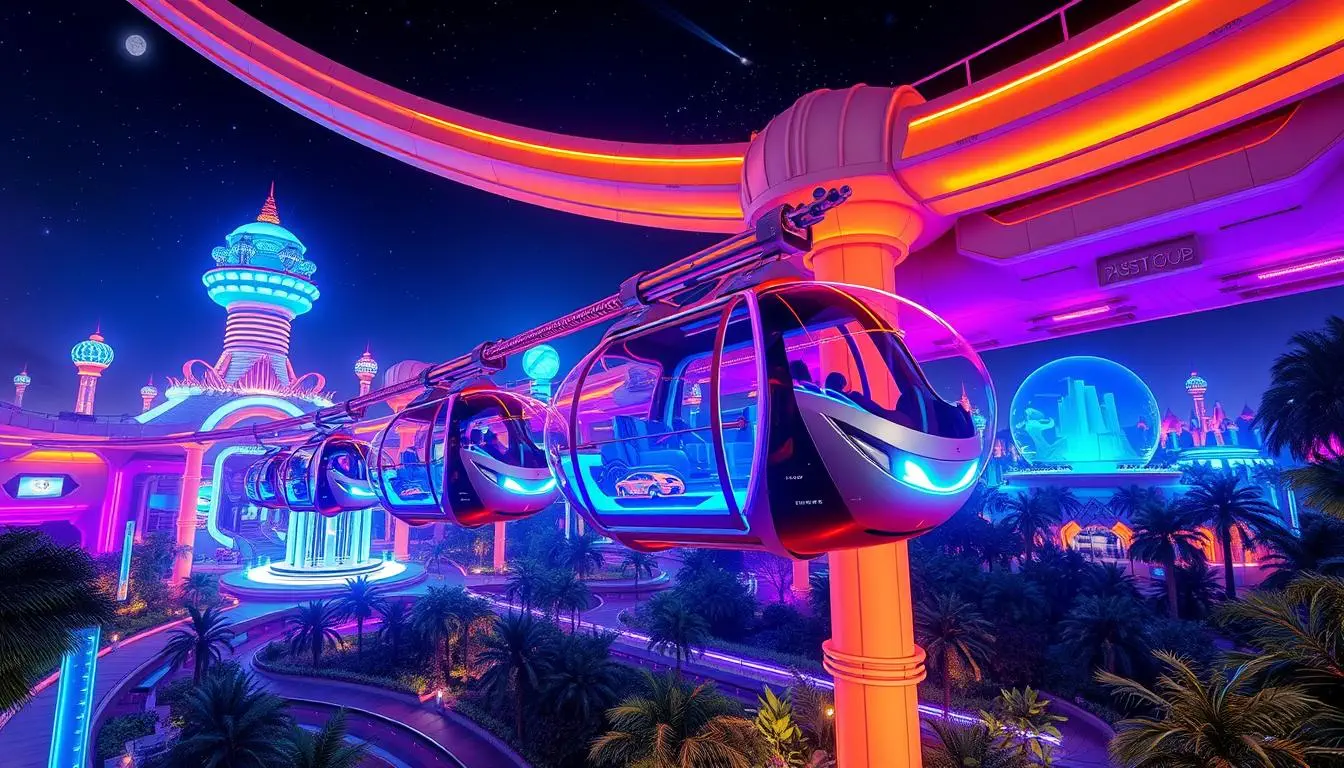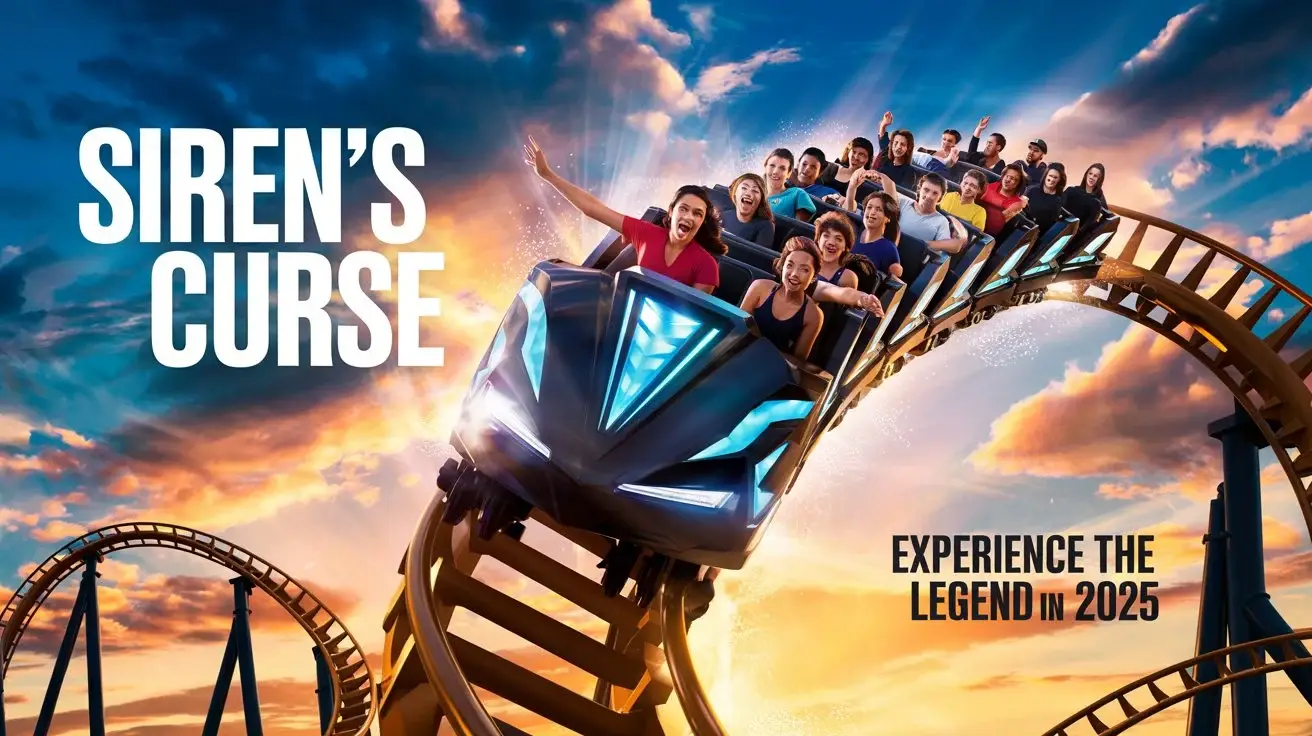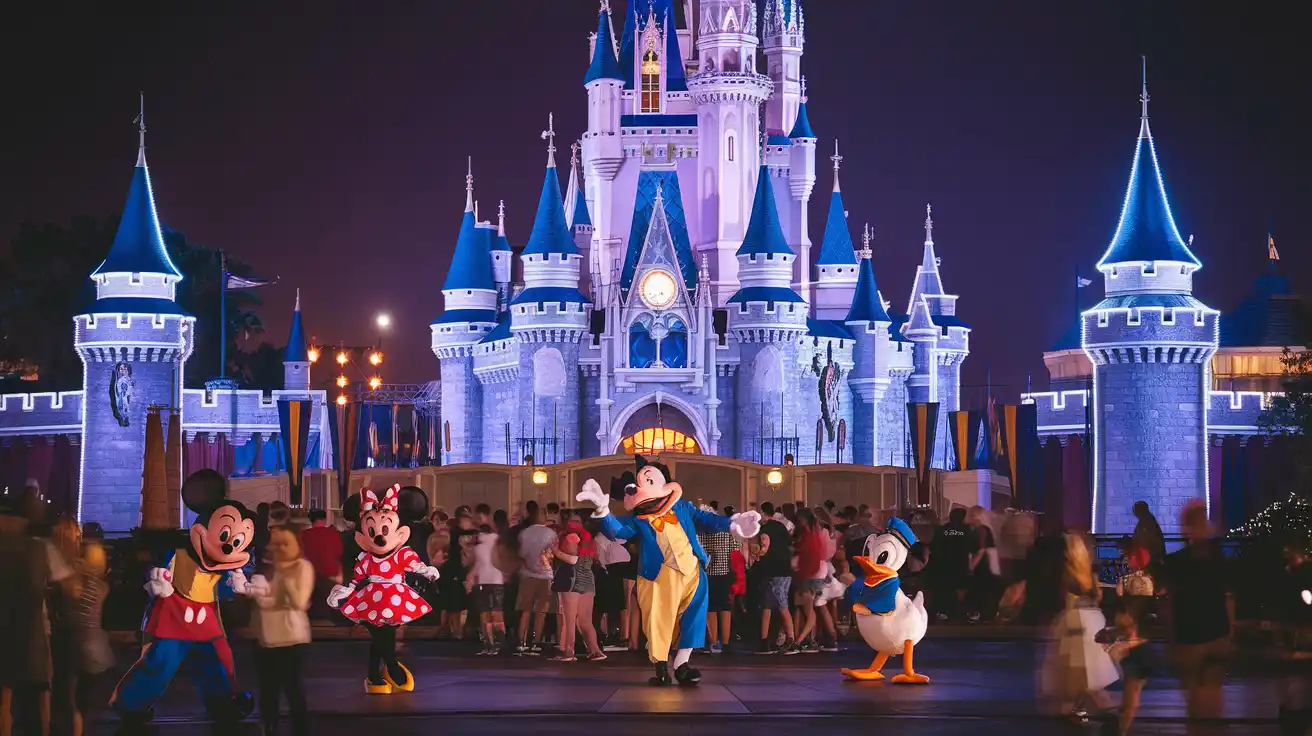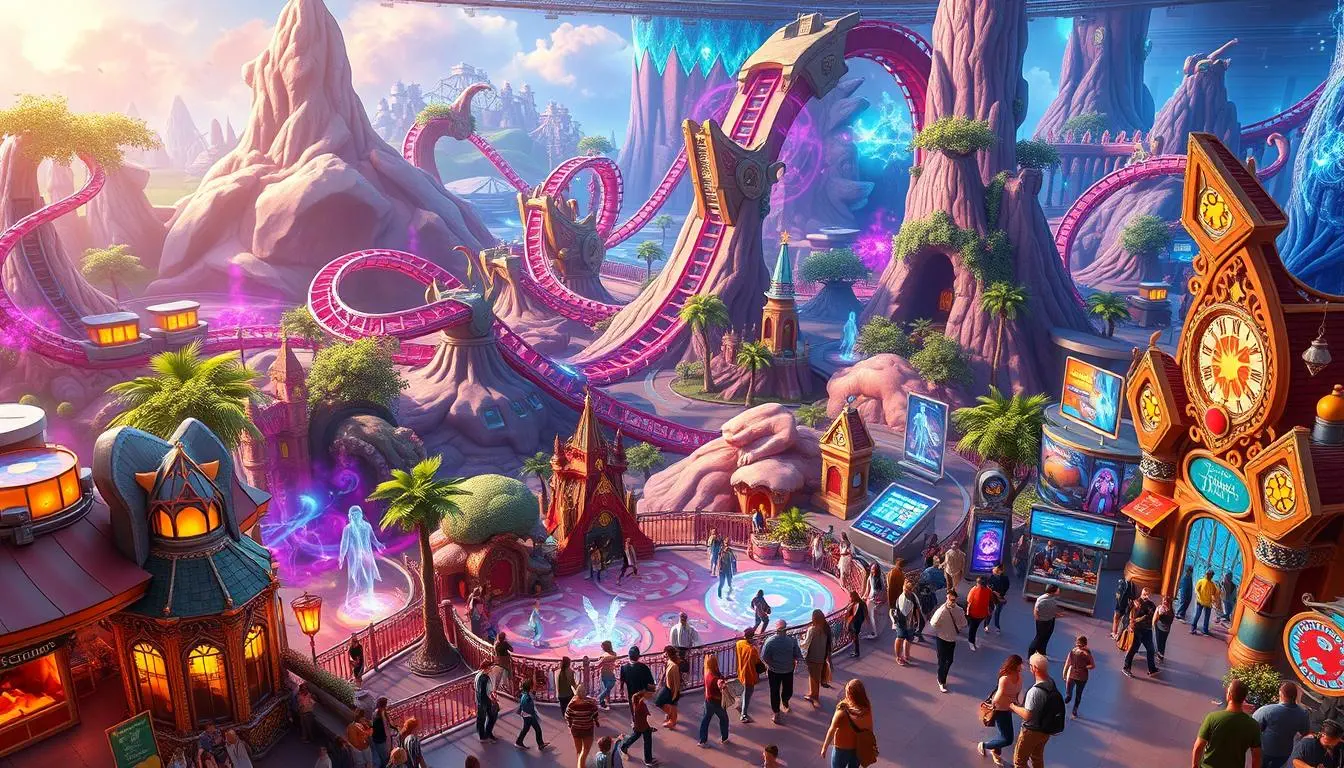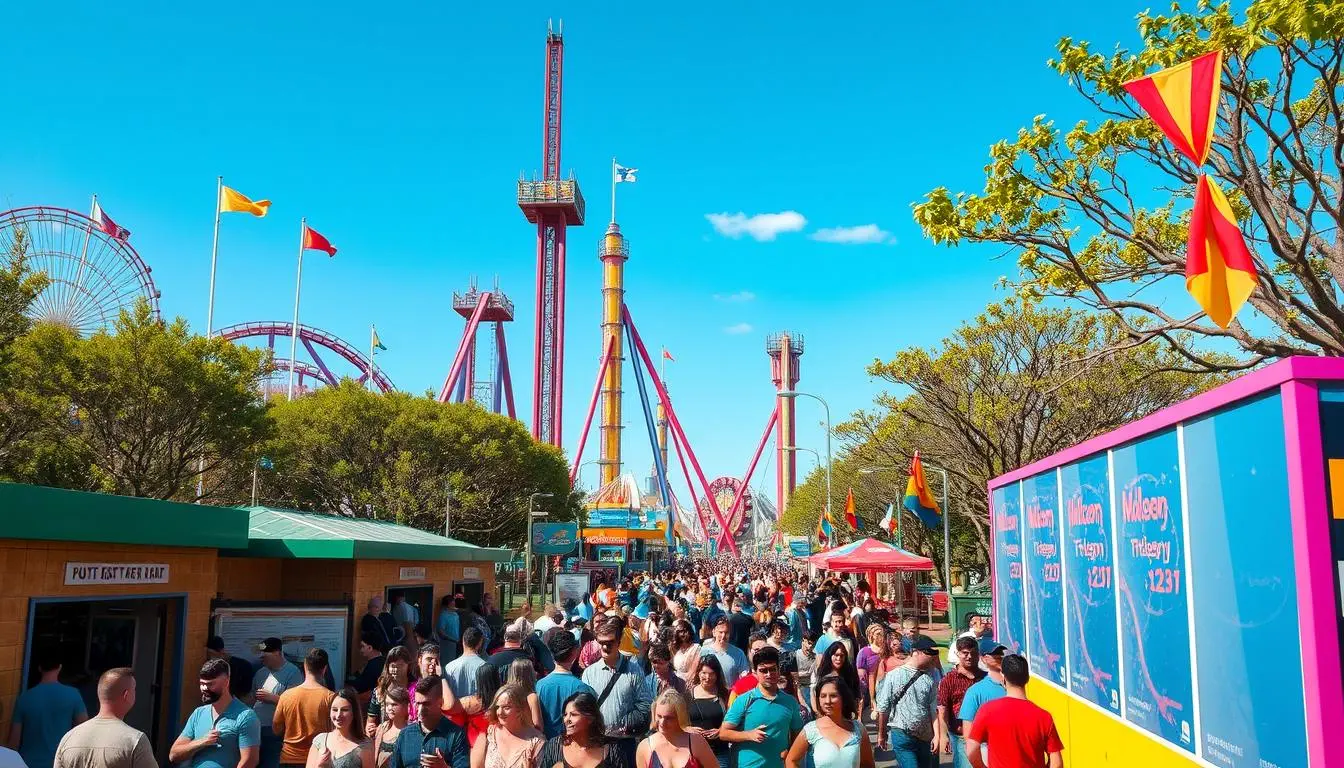The theme park industry is undergoing a significant transformation. This change is driven by the need to adapt to evolving consumer preferences and technological advancements. Most theme park rides are scheduled to open in 2025 or 2026, with a few having unknown opening dates1. This shift is leading to the development of innovative ride technology and interactive experiences. These are becoming increasingly popular among theme park visitors.
The Future of Theme Park Rides is exciting and rapidly evolving. Countries like Germany and the United States are at the forefront of this change. They feature new theme park rides such as roller coasters and dark rides1.
As the industry continues to evolve, we can expect to see more immersive and interactive experiences. The integration of virtual reality and augmented reality will allow visitors to engage with theme park rides in new and innovative ways. Companies like Disney and Universal are filing patents for new ride technology. This indicates a broader industry shift toward automated, interactive, and immersive systems2.
The Future of Theme Park Rides is all about creating unique and memorable experiences. It focuses on innovative ride technology and interactive experiences.
Key Takeaways
- The theme park industry is undergoing a significant transformation, driven by changing consumer preferences and technological advancements.
- Innovative ride technology and interactive experiences are becoming increasingly popular among theme park visitors.
- Countries like Germany and the United States are at the forefront of this change, featuring new theme park rides such as roller coasters and dark rides.
- The integration of virtual reality and augmented reality is expected to create more immersive and interactive experiences.
- Companies like Disney and Universal are filing patents for new ride technology, indicating a broader industry shift toward automated, interactive, and immersive systems.
- The Future of Theme Park Rides is all about creating unique and memorable experiences, with a focus on innovative ride technology and interactive experiences.
The Evolution of Theme Park Attractions
Theme parks have seen major changes over time, thanks to tech advancements and shifting consumer tastes. Today, they offer a variety of interactive experiences, like virtual and augmented reality attractions. These innovations aim to meet different audience needs3. This shift has made theme parks more immersive and engaging, distinguishing them from traditional entertainment.
Disney’s Magic Kingdom and Universal Studios are prime examples of theme parks embracing technology. Disney uses the My Disney Experience app to enrich guest experiences4. Universal Studios, on the other hand, employs Virtual Line technology to cut down wait times4. These advancements have not only enhanced guest satisfaction but also boosted the industry’s growth. The theme park market is expected to hit $82.73 billion by 20324.
Theme parks are now aiming to offer personalized experiences, leveraging data analytics to customize entertainment options for each guest4. Artificial intelligence is also being used to let visitors tailor their attraction experience5. As the industry evolves, we can anticipate even more groundbreaking and interactive experiences, including more virtual and augmented reality integration5.
The future of theme parks looks bright, with trends like virtual and augmented reality, immersive experiences, and sustainable practices leading the way45. As theme parks evolve to meet changing consumer demands and technological progress, we can look forward to even more innovative and captivating attractions.
The Rise of Virtual Reality Experiences
Virtual reality is transforming theme parks, bringing visitors immersive and interactive experiences. The global theme park market hit USD 50.6 billion in 20226. It’s expected to grow at a 6.2% CAGR from 2023 to 20286. This expansion is fueled by tech like VR, AR, and AI, which are making experiences more immersive6.
Innovative ride tech is also key in the rise of VR experiences. The AR VR market is set to hit 40 billion US dollars by 20247. VR headsets’ advancement is leading the charge in immersive theme park experiences7. Interactive experiences are gaining traction, making parks more accessible and inclusive by removing location barriers7.
Some major benefits of VR in theme parks include:
- Enhanced guest engagement
- Increased revenue through immersive experiences
- Improved accessibility and inclusivity
The global VR software market revenue is expected to reach 4.3 billion USD in 20248. The US will account for 23% of this, with a 7.46% CAGR until 20298. As VR tech advances, we’ll see more innovative and interactive park experiences.
Augmented Reality: Blending Real and Virtual
Augmented reality attractions are transforming the theme park scene, merging digital elements with the real world9. This tech allows for real-time interactions between 3D models of virtual and real items, making experiences deeply immersive for guests9. For example, Universal’s Mario Kart: Bowser’s Challenge ride at Super Nintendo World uses AR goggles. Riders see classic Mario Kart objects around them, enabling them to interactively play like launching shells at other racers9.
Some of the key benefits of augmented reality attractions include:
- Enhanced visitor engagement through interactive experiences
- Increased revenue through innovative ride technology
- Improved educational value through immersive and interactive exhibits
Research shows augmented reality has boosted the tourist experience by 90%, changing how travelers interact with attractions10. The revenue from augmented reality in attractions is expected to hit $50 billion by 2027, marking a notable increase10. Augmented reality in theme parks has also been successful, boosting foot traffic to in-park souvenir and gift shops10.
In summary, augmented reality attractions are revolutionizing the theme park experience, introducing innovative ride technology and interactive experiences that captivate visitors of all ages9. As this technology advances, we can anticipate even more groundbreaking uses of augmented reality in theme parks and other attractions10.
Cutting-Edge Technology Shaping Rides
Innovative ride technology is transforming the theme park industry. It brings cutting-edge amusement park designs and advanced thrill ride concepts. These innovations aim to create immersive experiences for visitors11. Artificial intelligence, robotics, and virtual reality are increasingly used. For example, the Mission Ferrari ride at Ferrari World Abu Dhabi and the One Epic Ocean show at SeaWorld park showcase these advancements11.
Key technologies driving these immersive experiences include:
- Artificial intelligence (AI) to personalize ride preferences and predict preferred attractions12
- Virtual reality (VR) to create realistic and interactive experiences11
- Augmented reality (AR) to enhance the ride experience with virtual objects and information11
- Robots to create interactive and dynamic experiences, such as robotic Spider-Man performances and free-roaming Baby Groot robots11
These technologies allow theme parks to offer unique and engaging experiences. For instance, the Hologram Zoo in Australia uses laser light technology for holographic animal displays11. Blockchain technology is also being explored to improve ticketing and payment systems. This could eliminate long queues and counterfeit tickets12.
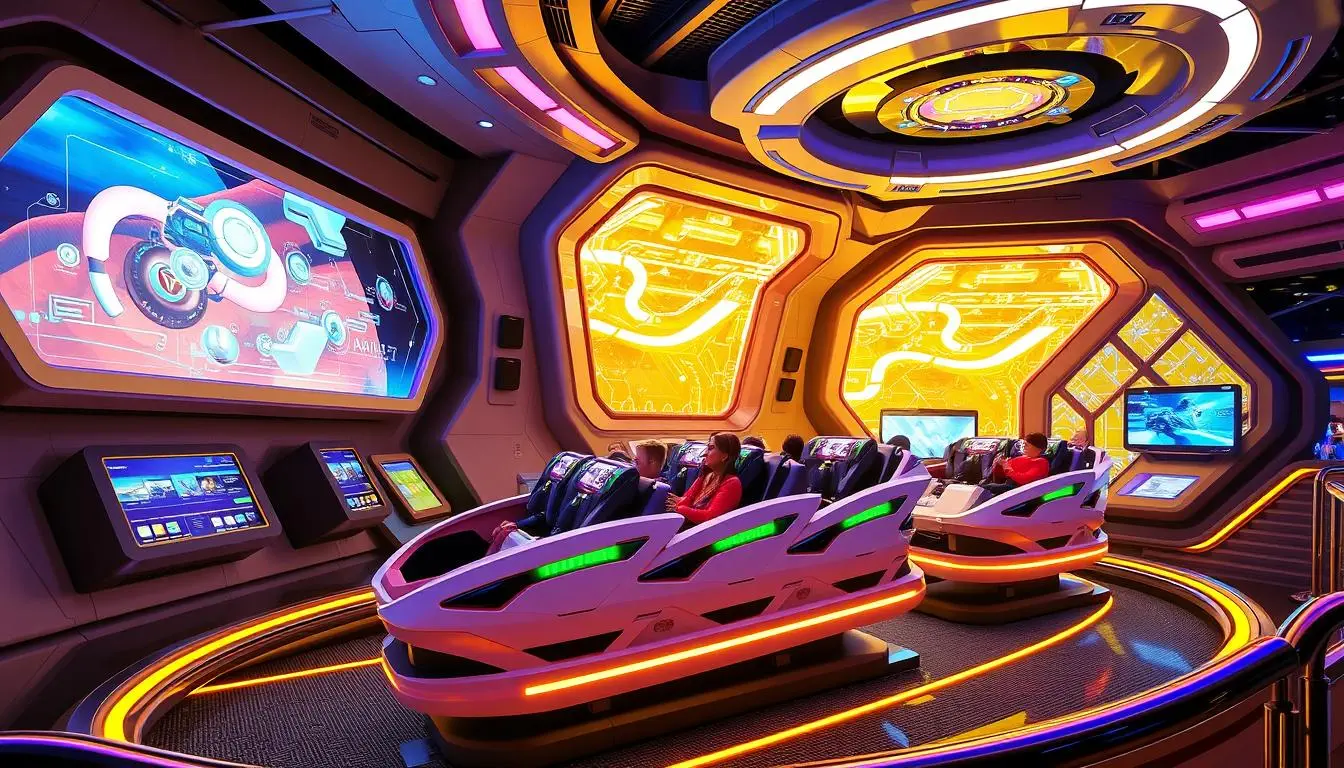
The theme park industry is being revolutionized by innovative ride technology and cutting-edge designs. These advancements enable the creation of immersive and interactive experiences. Visitors are sure to be thrilled by these new developments11.
| Technology | Application | Example |
|---|---|---|
| Artificial Intelligence (AI) | Personalize ride preferences | Mission Ferrari ride at Ferrari World Abu Dhabi11 |
| Virtual Reality (VR) | Create realistic and interactive experiences | One Epic Ocean show at SeaWorld park11 |
| Augmented Reality (AR) | Enhance the ride experience | Hologram Zoo in Australia11 |
Sustainability in Theme Park Ride Design
Sustainability is now a key focus in theme park ride design, as parks aim to lessen their environmental footprint. They are adopting eco-friendly materials and energy-efficient rides in their designs13. For instance, Korkeasaari Zoo in Helsinki, Finland is striving to be carbon neutral by 2030. It has already cut its carbon footprint by 40% through green electricity and renewable district heating13.
Theme parks are implementing various strategies to achieve sustainability. These include:
- Utilizing renewable energy sources, like solar power, to reduce energy usage
- Implementing water conservation systems to lower water consumption
- Reducing waste through recycling and composting programs
The global Amusement Parks Market is projected to expand at a CAGR of 6.2% by 202914. The Mechanical Rides segment is expected to hold the largest market share. As the market expands, sustainability will likely play a more significant role in theme park ride design. By integrating eco-friendly materials and energy-efficient rides, parks can minimize their environmental impact. This appeals to visitors increasingly concerned about sustainability13.
| Park | Sustainability Initiative | Results |
|---|---|---|
| Korkeasaari Zoo | Green electricity and renewable district heating | 40% reduction in carbon footprint |
| Six Flags Magic Mountain | Solar carport structure | 100% offset of energy usage |
| Water World Ocean Park | Water filtration system | Up to 90% reduction in water consumption |
By focusing on sustainability in theme park ride design, parks can offer a greener and more appealing experience. This not only benefits visitors but also contributes to a more sustainable future13.
Interactive Rides: Engaging All Ages
Theme parks are shifting their focus towards interactive experiences, aiming to engage a wide range of visitors. They’re using innovative ride technology and gamification to make the experience more enjoyable15. This is evident in attractions like Disney’s Spider-Man W.E.B. Adventure, which offers personalized and varied gameplay16.
Interactive rides like Maus au Chocolat at Phantasialand and Action League are perfect examples. Maus au Chocolat is a shooting game where guests compete against virtual mice. Action League, on the other hand, pits teams against each other in a dynamic, multi-axis rotation environment16. These rides show how interactive experiences can captivate visitors of all ages.
Katie Baker from Simworx highlights the benefits of interactive walkthroughs. They can increase revenue, boost guest engagement, and improve guest flow15. Attractions like Meow Wolf exemplify this, blending world-building with guest interpretation, with 30% basics, 20% prescribed elements, and 50% creative freedom for artists15.
Theme parks are also using cutting-edge technology to create immersive experiences. For instance, dynamic media captures the lively essence of IPs like the Minions16. Interactive elements, such as virtual and augmented reality, further enhance the experience, as seen in the Bobcat roller coaster at Six Flags Great Escape17.
The trend towards interactive experiences and gamification in theme parks aims to create engaging and immersive experiences for all. Parks are employing innovative ride technology to meet this goal15.
Safety Innovations for Thrill Seekers
Theme parks are always pushing the boundaries to offer new and thrilling experiences, all while ensuring safety. The role of safety innovations in thrill ride development cannot be overstated. Ride safety technology is advancing swiftly to cater to the needs of thrill enthusiasts18. The integration of advanced materials and state-of-the-art technology, like high-strength steel and CAD, is revolutionizing roller coaster design. This approach ensures both an immersive experience and a focus on safety19.
Recent advancements include the application of virtual reality to simulate coaster rides before actual construction. This allows designers to fine-tune the design for both thrill and safety19. The incorporation of AI and machine learning is also transforming roller coaster design. It’s creating more personalized and engaging experiences for riders19. The introduction of attractions like the Maurer Spike coaster, with electric motors for speed control and enhanced safety, highlights the industry’s dedication to safety20.
Here are some key features of modern roller coasters that prioritize safety:
- Advanced restraints to keep riders secure
- Regular maintenance to ensure optimal performance
- Use of virtual reality to simulate rides before construction
- Implementation of emerging technologies like AI and machine learning
As the theme park industry continues to evolve, safety innovations will remain essential. They will be key in the creation of new thrill ride concepts and advancements in ride safety technology. This will ensure visitors enjoy exciting and safe experiences181920.
The Influence of Customer Feedback
Theme parks are increasingly turning to customer feedback to craft experiences that align with the evolving tastes of their visitors. By tapping into social media insights, they gain a deeper understanding of what their customers expect. This allows them to adapt to the shifting demands4. For example, Disney’s My Disney Experience app empowers guests to unlock hotel rooms, secure ride reservations, and order food, significantly improving their visit4.
Theme parks also leverage data analytics to offer personalized experiences based on guest preferences4. This includes introducing virtual reality attractions, interactive rides, and immersive experiences. By investing in a unified digital platform, they can enhance guest experiences and boost recurring revenue4.
Some notable examples of theme parks using customer feedback include:
- Universal Studios’ Virtual Line technology, which lets visitors reserve ride times and enjoy other attractions without waiting in line4
- LEGOLAND’s app, which provides real-time updates on wait times and features an interactive map for guest navigation4
- Disney’s dedication to using data analytics for personalized experiences, evident through its tailored recommendations on the My Disney Experience app21
By focusing on customer feedback and social media insights, theme parks can craft unique and engaging experiences that cater to the evolving needs of their visitors21. This approach fosters increased customer loyalty and satisfaction, as seen in Disney’s strong loyalty among millennials and Gen Z21.
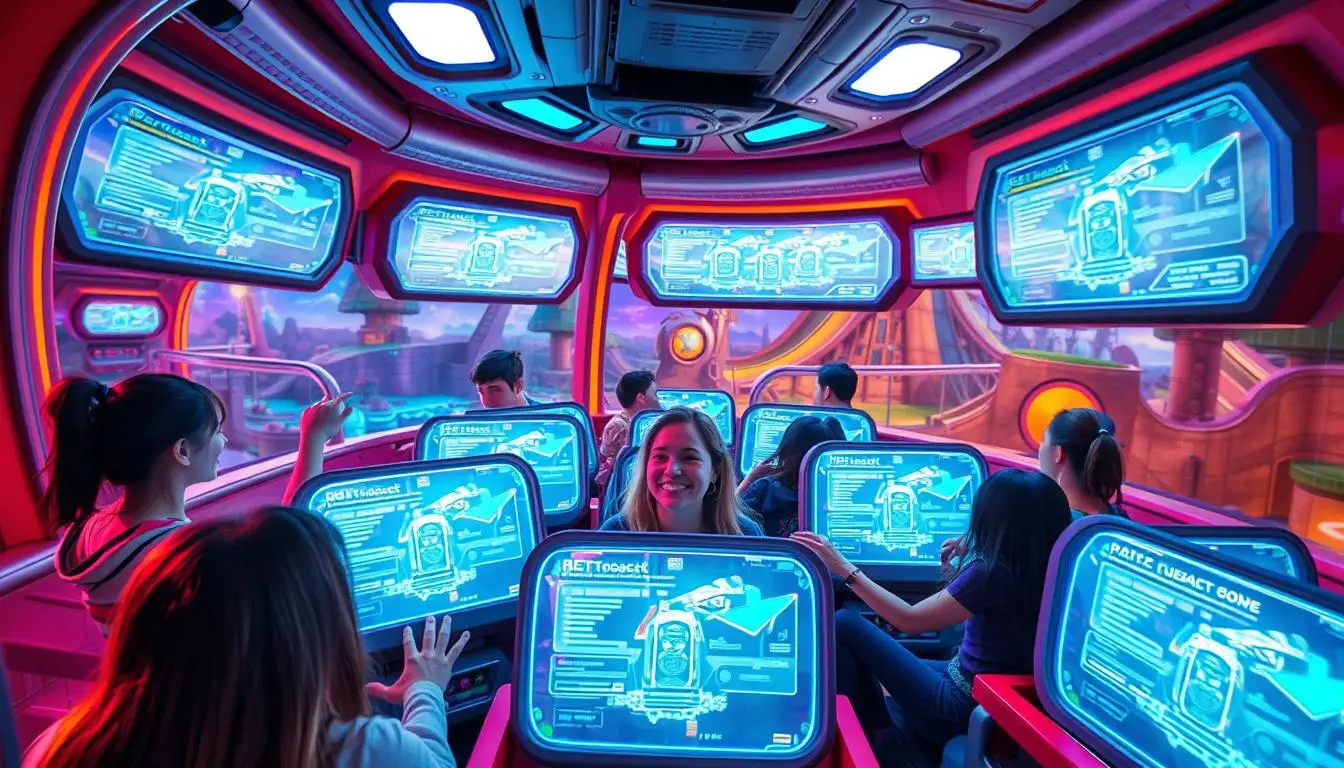
The impact of customer feedback is vital in shaping the future of theme park design and operations. By embracing this feedback and adapting to changing demands, theme parks can create immersive and engaging experiences. These experiences drive recurring revenue and customer loyalty4.
| Theme Park | Initiative | Impact |
|---|---|---|
| Disney | My Disney Experience app | Enhanced guest experience, increased convenience |
| Universal Studios | Virtual Line technology | Reduced wait times, increased guest satisfaction |
| LEGOLAND | Real-time updates and interactive map | Improved guest navigation, increased engagement |
The Role of Theming in Ride Experiences
Theming is a vital part of the theme park experience, crafting immersive environments that pull visitors into the ride’s world. The themed entertainment industry is vast, with Walt Disney Imagineering alone boasting over 100 job classifications22. This shows the depth and detail required to create these environments.
Immersive environments and storylines are key to theming, making the experience richer and more engaging. For instance, Germany’s Eatrenalin combines dark ride techniques with fine dining, providing an immersive multi-sensory journey with each of its eight courses served in different rooms22. This example illustrates the power of theming in crafting unforgettable experiences.
Some notable examples of immersive theming include:
- Mario Kart: Bowser’s Challenge at Universal Studios Hollywood, which focuses on interactivity and playfulness over speed and thrills22
- Disney’s Star Wars: Rise of the Resistance, considered the company’s most technologically advanced attraction23
- Super Nintendo World at Universal Studios Japan, which aims to create a “life-size living video game” experience23
These examples highlight the significance of theming in creating engaging and immersive experiences. By integrating immersive environments and storylines, theme parks can offer unique and memorable experiences that attract and retain visitors23.
Future Trends in Theme Park Ride Development
The theme park industry is rapidly evolving, necessitating a focus on future trends in ride development. Anticipating visitor expectations is key, facilitated by AI-driven data analysis for personalized adventures24. This technology also aids in optimizing energy, water, and waste management, boosting sustainability efforts24.
Top technology trends for 2024 include robots, AI, and immersive technologies25. These innovations enable the creation of immersive, interactive experiences. For instance, wearable wristbands linked to smartphones enhance gamified lands25. AR glasses with eye and face tracking provide real-time data on guest reactions, enriching the guest journey26.
AI is being used to create dynamic experiences, varying each time visitors interact with it24. Universal Orlando’s Epic Universe theme park will feature a land inspired by classic monsters25. By embracing these trends, parks can deliver unique, memorable experiences that exceed visitor expectations.
The future of theme park ride development is brimming with possibilities. By integrating AI, AR, and immersive technologies, parks can offer thrilling, sustainable experiences. As the industry advances, staying ahead of visitor expectations is vital for creating unforgettable moments242526.
Collaborations with Content Creators
Theme parks are increasingly teaming up with content creators to craft immersive experiences that resonate with fans of popular franchises27. This shift is driven by the need to differentiate themselves from other entertainment venues. By collaborating, theme parks leverage the creative prowess of content creators to develop experiences that are both captivating and memorable.
These partnerships allow for the creation of interactive, immersive experiences that highlight beloved franchises28. For instance, theme parks can develop virtual reality experiences that transport guests into the world of their favorite movies or TV shows. Such experiences are enhanced by cutting-edge technology, like the Intel Smart Display Module (SDM), which enables the integration of new innovations in experiential entertainment28.
Collaborations also enable theme parks to craft engaging, informative content that showcases their attractions and experiences27. This includes behind-the-scenes glimpses and previews of upcoming attractions, building anticipation and fostering a community of enthusiasts. By tapping into the creative expertise of content creators, theme parks can produce content that is both entertaining and informative. This content drives business growth and enhances their brand prestige27.
Some notable franchises featured in theme park collaborations include
- Movie franchises, such as Star Wars and Harry Potter
- TV shows, such as Game of Thrones and The Walking Dead
- Video game franchises, such as Minecraft and Fortnite
. These collaborations have resulted in immersive, engaging experiences that appeal to fans of all ages28.
In summary, collaborations with content creators are a significant trend in the theme park industry, expected to persist in the future29. By working with content creators, theme parks can develop unique, immersive experiences that resonate with fans of popular franchises. These experiences drive business growth and elevate brand prestige.
The Future of Space Exploration Rides
The theme park industry is constantly innovating, leading to the emergence of space exploration rides as a thrilling new area. Space-themed attractions allow visitors to feel the excitement of space travel, combining advanced technology with engaging stories30. By working with aerospace companies, parks aim to deliver unforgettable experiences that appeal to all ages30.
Imagine virtual reality coasters that mimic the feeling of space travel or interactive dark rides that take you to other planets. The options are vast. VR coasters like “Ghostbusters: Dimension” at Madame Tussauds New York and “Galactica” at Alton Towers offer personalized adventures, letting riders pick their experience level and dive into the story30. Also, advancements in motion simulation and holographic tech are making space exploration rides even more immersive and exhilarating30.
The industry’s growth means space exploration rides will likely become a top attraction for thrill-seekers and space fans31. With the help of forward-thinking aerospace companies and the ingenuity of theme park designers, the future of space-themed attractions is looking brighter than ever30.

